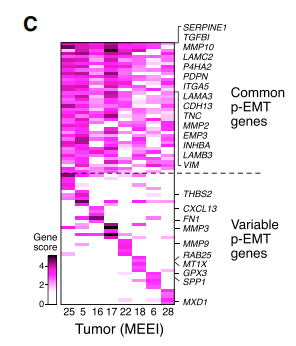- 1 EMT相关状态和基因
- https://www.nature.com/articles/s41586-018-0040-3

这里提出上皮到EMT的过程不是一个二段的,是一个渐变的过程,因此将EMT分成了三个阶段。">https://www.nature.com/articles/s41586-018-0040-3
这里提出上皮到EMT的过程不是一个二段的,是一个渐变的过程,因此将EMT分成了三个阶段。
1 EMT相关状态和基因
1.
## EMT转录因子genes <- c("SNAI1", "PRRX1", "TWIST1", "ZEB1", "ZEB2")## EMT信号基因genes <- c("PDGFRB", "FAP")# 不同阶段的EMT基因genes <- c("KRT17", "KRT14", # early EMT"ZEB1", "VIM", # common EMT"ASPN", "COL24A1") # last EMT
https://www.nature.com/articles/s41586-018-0040-3

这里提出上皮到EMT的过程不是一个二段的,是一个渐变的过程,因此将EMT分成了三个阶段。
2.
## 1 pEMT genesgene1 <- c("SERPINE1", "TGFB1", "MMP10", "LAMC2", "P4HA2", "PDPN", "ITGA5", "LAMA3", "CDH13", "TNC","MMP2", "EMP3", "INHBA", "LAMB3", "VIM")
https://www.cell.com/cell/fulltext/S0092-8674(17)31270-9?_returnURL=https%3A%2F%2Flinkinghub.elsevier.com%2Fretrieve%2Fpii%2FS0092867417312709%3Fshowall%3Dtrue#supplementaryMaterial31270-9?_returnURL=https%3A%2F%2Flinkinghub.elsevier.com%2Fretrieve%2Fpii%2FS0092867417312709%3Fshowall%3Dtrue#supplementaryMaterial)

头颈肿瘤的一篇cell文章,里面用的单细胞测序。和其他不同的是这么没有在测序前确定个EMT细胞状态,而且通过基因表达确定了pEMT,因此具有较大的参考价值。
2 如何定义EMT和pEMT
这里还是引用头颈肿瘤的那一篇cell文章,里面有过一段论述:
While the program had key features of classical EMT, it lacked other hallmarks. First, although the signature was accompanied by reduced expression of certain epithelial genes, overall expression of epithelial markers was clearly maintained (Figures S331270-9?returnURL=https%3A%2F%2Flinkinghub.elsevier.com%2Fretrieve%2Fpii%2FS0092867417312709%3Fshowall%3Dtrue#figs3)D and S3E). Second, we did not detect expression of the classical EMT TFs, ZEB1/2, TWIST1/2, and SNAIL1. Only SNAIL2 was detected (in 70% of HNSCC cells), and while its expression correlated with the program across tumors, it did not correlate with the program across individual cells within a tumor (Figure S331270-9?_returnURL=https%3A%2F%2Flinkinghub.elsevier.com%2Fretrieve%2Fpii%2FS0092867417312709%3Fshowall%3Dtrue#figs3)F). Recent work suggests that SNAIL2 peaks earlier than other EMT TFs ( van Dijk et al., 201731270-9?_returnURL=https%3A%2F%2Flinkinghub.elsevier.com%2Fretrieve%2Fpii%2FS0092867417312709%3Fshowall%3Dtrue#bib43) ). SNAIL2 is also implicated in a p-EMT response in wound healing ( Savagner et al., 200531270-9?_returnURL=https%3A%2F%2Flinkinghub.elsevier.com%2Fretrieve%2Fpii%2FS0092867417312709%3Fshowall%3Dtrue#bib33) ). We note that EMT is increasingly recognized to be a continuous and variable process ( Lambert et al., 201731270-9?_returnURL=https%3A%2F%2Flinkinghub.elsevier.com%2Fretrieve%2Fpii%2FS0092867417312709%3Fshowall%3Dtrue#) , Lundgren et al., 200931270-9?_returnURL=https%3A%2F%2Flinkinghub.elsevier.com%2Fretrieve%2Fpii%2FS0092867417312709%3Fshowall%3Dtrue#) , Nieto et al., 201631270-9?_returnURL=https%3A%2F%2Flinkinghub.elsevier.com%2Fretrieve%2Fpii%2FS0092867417312709%3Fshowall%3Dtrue#) ). We therefore suggest that the _in vivo program identified here reflects a partial EMT-like state or “p-EMT.”
这里作者提出了三点理由:
- 首先,尽管该特征伴随着某些上皮细胞基因表达的减少,但上皮细胞标志物的总体表达明显保持。
- 其次,我们没有检测到经典EMT TFS,ZEB1 / 2,TWIST1 / 2和SNAIL1的表达。仅检测到了SNAIL2(在70%的HNSCC细胞中)。最近的研究表明,SNAIL2的峰值比其他EMT TFs的峰值更早,SNAIL2也与伤口愈合中的p-EMT反应有关
- 我们注意到,EMT越来越被认为是一个连续和可变的过程
- 一些额外的分析表明,这个p-EMT程序不同于来源于细胞系和肿瘤模型的完整的EMT程序,也不同于来源于整体肿瘤谱的间充质特征。
所以高分文章的一个特点就是对于所提出来的每一个发现,都提供充足的证据来令人信服。

